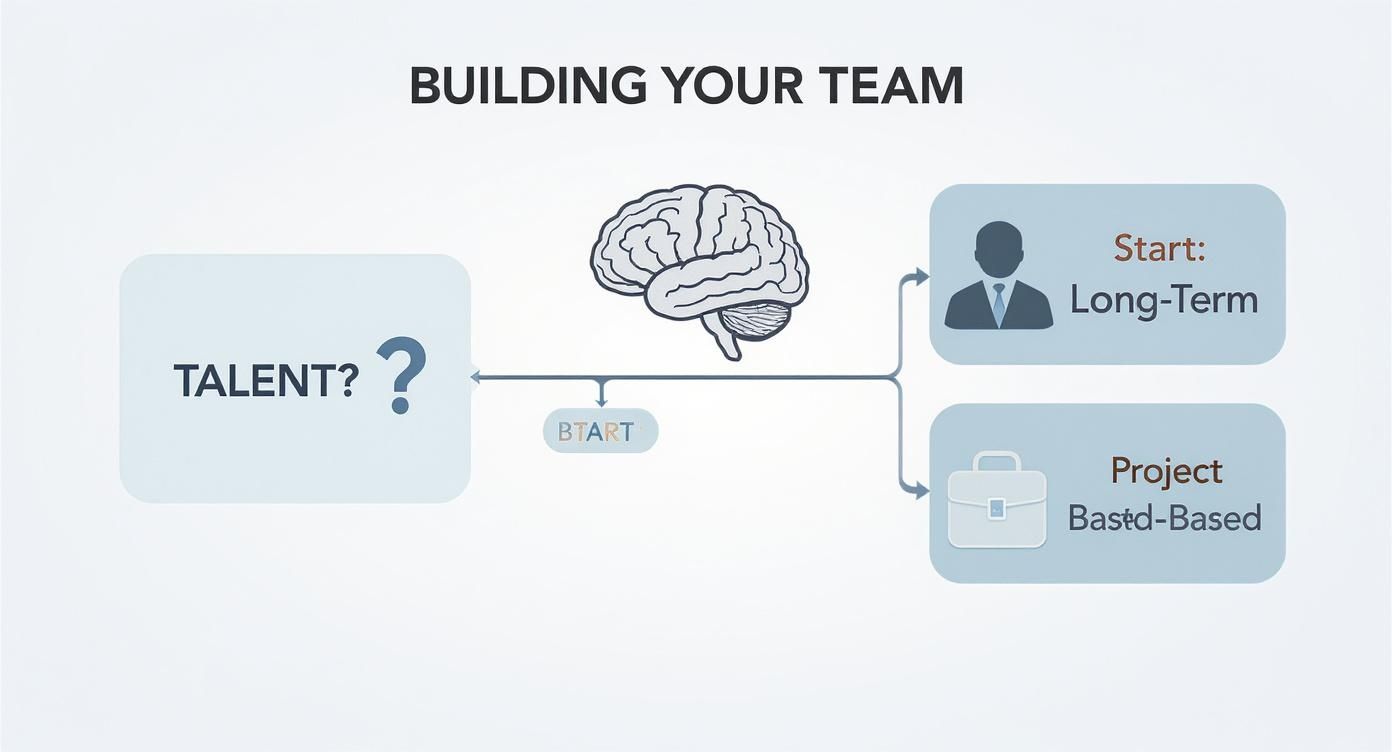
Let's be honest: the traditional hiring process is a slow, expensive gamble. Flexible staffing solutions offer a smarter way to build your A-team. Turns out there’s more than one way to hire elite developers without mortgaging your office ping-pong table. It’s about accessing on-demand talent, letting you scale your workforce exactly when you need it—without the dead weight of permanent hires.

We’ve all been there. You spend months—and a small fortune—courting the “perfect” full-time employee. You wine and dine them, get them to sign on the dotted line, and then three months later, it hits you: you’ve made a terrible, costly mistake.
The old “hire-for-life” playbook is failing modern businesses, and it’s not just about the occasional bad fit. It’s a fundamentally rigid system in a world that demands agility. Hope you enjoy spending your afternoons fact-checking resumes and running technical interviews—because that’s now your full-time job.
The sticker price of a new hire is just the tip of the iceberg. The real damage comes from the hidden costs that bleed your budget dry and drain your team’s momentum. These are the silent killers of productivity.
This isn’t just inefficient; it’s high-risk. You’re making a massive, long-term financial commitment based on a handful of interviews and a gut feeling. There has to be a better way.
What if you could tap into elite talent exactly when you need it, for precisely as long as you need it? That’s the core promise of flexible staffing. It’s a strategic shift from “owning” talent to “accessing” it.
Think of it like this: Instead of buying an entire orchestra just to play a single symphony, you hire the world’s best violinist for the solo and let them go when the performance is over. It’s efficient, targeted, and financially sane.
This isn’t about replacing your core team. It’s about augmenting them with specialized skills to tackle specific challenges—a product launch, a rebrand, or a complex software build. It’s time to stop gambling on permanent hires and start building a dynamic, resilient organization.
Let's cut through the corporate jargon. Flexible staffing solutions aren't just about calling a temp agency to cover the front desk while someone’s on vacation. That’s thinking too small. This is about re-engineering your entire workforce for growth, not just filling empty seats.
Think of your core, full-time team as your starting lineup. They’re your stars—reliable, deeply integrated, and they know your playbook cold. But what happens when you need a pinch hitter for one crucial at-bat? You don’t bench your MVP. You bring in a specialist.
That’s the essence of flexible staffing. It’s about building a deep bench of elite, on-demand specialists you can deploy to win critical moments: a huge software launch, a high-stakes rebrand, or a complex market expansion.
The biggest hurdle isn’t logistical; it's psychological. For generations, leaders were taught that "real" employees were the ones with W-2s and a dedicated parking spot. The goal was to own talent. Today, that model is a liability.
The new playbook is all about accessing talent. It’s a pivot from building a rigid army to cultivating a fluid network of experts. Why commit to a five-year salary for a skill set you only need for five months? The math just doesn't add up.
This isn't just a trend; it's a seismic shift. By 2025, the global flexible employment market is projected to hit a staggering $280 billion. This explosion isn't just about the gig economy; it’s a deliberate strategy by smart companies to build hybrid workforces.
This approach gives you the power to stay lean, pivot on a dime, and punch way above your weight class by tapping into a global reservoir of expertise without the crushing weight of permanent overhead.
When you embrace flexible talent, you're not just plugging gaps. You’re building a resilient, adaptable organization that can react to market shifts almost instantly.
Need to spin up a new marketing campaign overnight? Access a team of freelance creatives and performance marketers. Ready to launch that new mobile app? Bring in a specialized squad of UX/UI designers and native developers for the project's duration.
This model also injects incredible diversity and global perspective into your team. You're no longer confined to the talent pool within a 30-mile radius of your headquarters. Your next brilliant developer might be in Bogotá, and your next marketing genius could be working from Buenos Aires.
Of course, a distributed workforce has unique needs. This includes thinking about benefits, like understanding travel health insurance for remote workers and freelancers. It's all part of a support system that empowers top talent, regardless of their contract or location.
Ultimately, flexible staffing is about building for what’s next, not just what's now.
Alright, let's get real. Not all flexible staffing solutions are created equal. Choosing the wrong model is like bringing a spoon to a knife fight—you’re not set up for success. You have to pick the right tool for the job.
The options are vast, from the wild west of freelance marketplaces to the white-glove service of specialized talent platforms. So, which one is actually right for you? Let’s break it down, no fluff, just the hard truths from someone who's tried them all.
This decision tree can help you visualize that initial choice between a long-term strategic hire and a short-term project-based need.

As you can see, your first decision point is the level of commitment, which directly points you toward the best flexible staffing model for your situation.
This is your classic Upwork or Fiverr experience. It’s fast, it’s cheap, and it’s a total crapshoot. You post a gig, get a hundred proposals in an hour (most from bots), and then pray the person you hire is even remotely competent.
Best for: Small, one-off tasks where the stakes are low. Think designing a quick social media graphic or transcribing an audio file. If it goes wrong, you’re out fifty bucks, not fifty thousand.
The brutally honest truth: It’s the cheapest route, sure, but you pay for it with your own time. You become the project manager, the quality control department, and the HR team, all rolled into one. Have fun with that.
This is the old-school model. You call an agency, tell them you need a "resource," and they dig through their Rolodex to send you a few résumés. They handle some of the initial screening, which is a step up from marketplace chaos.
They're reliable for filling temporary, often on-site, roles with standard skill sets—think administrative assistants or event staff.
The problem? These agencies often lack deep technical or creative expertise. They’re generalists in a world that demands specialists. You might get someone who can do the job, but you'll rarely find someone who will truly elevate it.
It's a safe, if uninspired, choice. You’ll get a warm body in a seat, but you likely won’t find the A-player who will change the game.
Here, you’re bringing in a big-name firm or a boutique consultancy. They analyze your problems, produce a beautiful 80-page slide deck telling you what you already know, and then hand you a massive invoice.
This model is ideal for high-level strategic guidance when you genuinely don't know the path forward. They bring frameworks you simply don’t have in-house.
However, they are notoriously expensive and disconnected from the actual execution. There’s a world of difference between strategy and getting your hands dirty, a distinction you can explore further when comparing staff augmentation vs. consulting. Consultants advise; they don't typically build.
Okay, time for a little self-aware plug (toot, toot!). This is the model we’re pioneering at LatHire. Think of it as the best of all worlds: the vast talent pool of a marketplace, but with the rigorous vetting and white-glove support of a high-end agency.
These platforms do the heavy lifting for you. They source, vet, and match you with elite, specialized talent—like senior software engineers from Latin America who are already in your time zone. The candidates aren’t just random profiles; they’re professionals who have passed technical assessments and skills evaluations.
Best for: Critical, long-term projects where quality and reliability are non-negotiable. This is for when you need to build a new software product, scale your marketing team, or hire specialized operational roles without the traditional overhead.
The magic here is that you get access to a curated pool of A-players without having to become a full-time recruiter yourself. Platforms like ours also handle the messy stuff—international payroll, benefits, and legal compliance. You get the talent without the administrative nightmare.
To make it even clearer, here’s a quick-glance table breaking down the pros and cons of each model. Think of this as your cheat sheet for making a smart, fast decision.
| Model | Best For | Typical Cost | Speed to Hire | Quality Control |
|---|---|---|---|---|
| Freelance Marketplace | Small, low-risk tasks and one-off projects | $ | Very Fast (Hours/Days) | Low (DIY Vetting) |
| Traditional Agency | Temporary, generalist, or on-site roles | $$ | Moderate (Weeks) | Medium (Agency Screening) |
| High-Cost Consultant | High-level strategy and problem diagnosis | $$$$ | Slow (Weeks/Months) | Very High (Reputation-Based) |
| Specialized Platform | Critical long-term roles and specialized skills | $$$ | Fast (Days/Weeks) | High (Pre-Vetted Talent) |
Ultimately, the right choice depends entirely on your specific needs. Are you looking for a quick fix or a long-term strategic partner? The answer will guide you to the model that delivers the best value.

So, you're thinking about building your own freelance team from scratch. Great. I hope you enjoy your new full-time job as an unpaid global payroll and compliance officer.
This isn't a lecture; it's a cautionary tale. Going the DIY route with flexible staffing solutions looks smart, but it’s an absolute minefield. The "savings" you're chasing evaporate under the weight of hidden costs, administrative friction, and the soul-crushing process of sifting through a global pool of strangers.
Before you dive headfirst into the marketplace abyss, let's talk about the real price of going it alone.
Picture this: you've hired five amazing freelancers. High-fives all around, right? Not so fast. Now you’re juggling invoices in three different currencies, trying to make sense of cryptic W-8BEN forms, and wondering if you're supposed to file 1099s for a developer in Colombia.
Every new hire adds another layer of complexity until your accounting software looks like a Jackson Pollock painting.
The real cost of DIY hiring isn't the freelancer’s hourly rate. It’s the countless hours of your time spent on low-value administrative tasks. Your time is your most valuable asset—stop giving it away for free.
Here’s the part that should keep you up at night. Misclassifying a contractor can lead to catastrophic legal and financial penalties. The line between a 1099 contractor and a W-2 employee is razor-thin, and governments are cracking down. Hard.
Did you give them a company laptop? Set their working hours? Integrate them too deeply into your daily stand-ups? Congratulations, you might have just accidentally hired an employee without benefits, and the Department of Labor would love to chat with you.
These aren't just US-based problems. The global staffing industry is projected to hit $650 billion by 2025, with the US, UK, and Japan dominating over 50% of the market. This scale highlights just how complex international labor laws are. You can get more insights on navigating these global complexities to see what you're up against.
The biggest lie of DIY hiring is that you have access to a world of talent. What you actually have is access to a world of profiles—most of which are unvetted, unverified, and, frankly, unbelievable.
You’re forced to become a detective, trying to validate someone’s skills based on a portfolio that might not even be theirs. It’s a grueling process that usually ends one of two ways:
This isn't meant to scare you off flexible staffing—it's meant to prepare you. The DIY path is a full-time job loaded with risk. The alternative is to find a partner who has already done the dirty work.
Let's be honest—the old way of finding temporary help was a mess. It involved digging through a dusty Rolodex or making a frantic call to a staffing agency that hadn't updated its database since Y2K. You'd get a résumé, cross your fingers, and hope for the best.
That era is over. Thank goodness.
Modern flexible staffing solutions are powered by technology that makes the old model look like it was carved on stone tablets. We're talking about sophisticated platforms that do the heavy lifting, turning what was once a high-stakes gamble into a calculated, strategic move.
The biggest shift? We've moved past the keyword-stuffed résumé and into the age of intelligent matching. No more wasting afternoons trying to decipher if "proficient in Java" means a candidate wrote "Hello World" once or architected a system for a bank.
Today’s talent platforms use machine learning to vet, verify, and match candidates with a level of accuracy that’s almost spooky.
If you want a deeper look, our guide on how AI-powered recruitment tools are making this possible breaks down the "how" behind the magic.
Finding the right person is only half the battle. The other half used to be the soul-crushing administrative work: navigating contracts, international payments, and the terrifying maze of legal compliance.
Technology has automated this entire mess into oblivion.
The new breed of talent platforms acts as your all-in-one HR and legal department. They handle the messy back-end work—from generating compliant contracts to processing cross-border payroll—so you can focus on getting the work done.
This shift is more than a convenience; it's a fundamental change. It's no surprise that the temporary staffing software market is projected to surge from USD 3.65 billion in 2024 to an incredible USD 11.13 billion by 2035. This explosive growth, detailed on Spherical Insights, shows a clear trend: businesses are ditching administrative headaches for tech-driven efficiency.
Technology has democratized access to elite global talent. Now, your next A-player isn't just in the next town over—they could be anywhere in the world, just a few clicks away.

So you’ve hired some killer remote talent. Fantastic. Now for the hard part: making them feel like they’re truly part of the team, not just glorified gig workers. If you treat your flexible team members like disposable assets, they’ll act accordingly—and you’ll lose them the second a better project comes along.
Integrating your hybrid team isn’t about sending a welcome basket and hoping for the best. It's a deliberate effort to build a single, unified culture where contribution matters more than a contract type. Get this wrong, and you’ll end up with two companies operating under one roof: the “real” team and the outsiders.
First impressions are everything, especially when you’re not sharing an office. A sloppy onboarding tells your new hire one thing loud and clear: you don’t value their time. It’s a surefire way to kill enthusiasm before they’ve written a single line of code.
Your goal is to get them from zero to productive as painlessly as possible. This means having a repeatable system in place long before Day One. We’ve learned that a structured approach is non-negotiable, a topic we cover in our deep dive on onboarding remote workers.
A solid process should include:
When you’re not physically together, you have to over-communicate. The casual "water cooler" conversations that solve problems in an office simply don’t happen for remote team members. Silence is easily misinterpreted as disinterest or confusion.
The golden rule for a hybrid team: if you think something is obvious, say it anyway. Repeat it. Put it in writing. What feels like over-communication to you is just the right amount for someone working hundreds of miles away.
This means using your collaboration tools with intention. Slack isn't just for GIFs; it's your virtual office. Project management tools like Asana or Jira aren't just for tracking tasks; they are your single source of truth. Encourage public channels over private DMs whenever possible to keep everyone in the loop.
Finally, you have to actively fight against proximity bias—our natural tendency to favor the people we see every day. This is the silent killer of hybrid teams. If promotions and interesting projects only go to the folks in the office, your best remote talent will walk.
How do you combat this?
Integrating a hybrid team takes real work, but it’s how you turn flexible staffing solutions from a cost-cutting tactic into a true competitive advantage.
Alright, you've made it this far, which means you’re probably thinking, "This all sounds great, but…" Good. Skepticism is healthy. Here are the quick, no-nonsense answers to the questions likely bouncing around your head.
This is a big one, and it's simpler than you think. Reputable flexible staffing platforms aren’t just glorified job boards; they’re legal fortresses. Every contractor signs robust agreements, including ironclad NDAs and IP assignment clauses, before they even see your project brief.
This means all work product—the code, the designs, the strategy—is legally transferred to you, the client. You get the same legal protections you'd have with a full-time employee.
Absolutely not. That’s an outdated view. While it’s perfect for plugging short-term gaps, one of the most powerful uses for flexible staffing solutions is for long-term, strategic roles.
Think of it as "Talent-as-a-Service." You can engage a senior data scientist for the long haul, accessing elite expertise without the permanent headcount. This allows you to scale critical functions up or down as your business evolves.
The power move is embedding flexible talent into your core strategy. You're not just hiring a contractor; you're subscribing to a skill set.
This question gets to the core value of a good staffing partner. You don't ensure quality—we do. That's the entire point. You're outsourcing the soul-crushing part of hiring so you can focus on your business.
A top-tier platform’s entire reputation rests on its vetting process. This often includes multi-stage technical exams, rigorous portfolio reviews, and reference checks. By leveraging a partner, you're buying back your time and massively reducing your hiring risk. We’re not saying we’re perfect. Just more accurate more often.